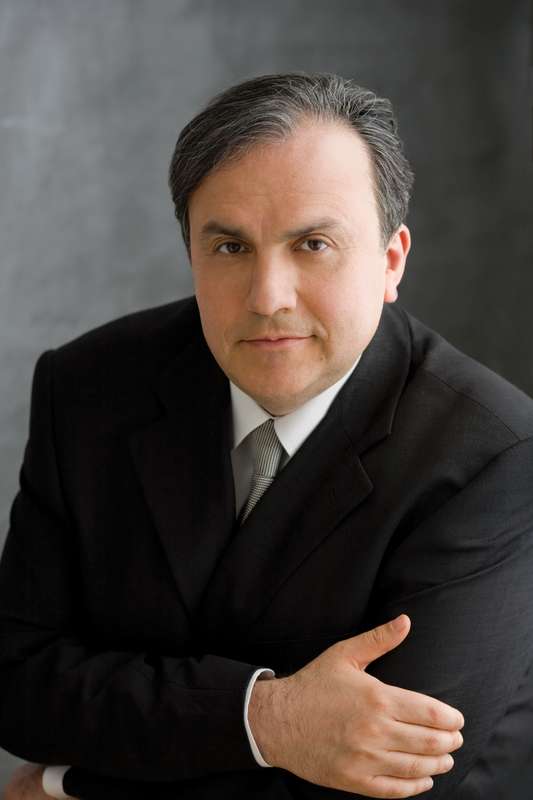Bronfman launches BSO Beethoven series with style, élan

Yefim Bronfman performed Beethoven’s first two piano concertos Thursday night with Christoph von Dohnanyi and the BSO.
So, why is there a mini-festival of Beethoven piano concertos going on this week and next with the Boston Symphony Orchestra in Symphony Hall?
It’s not the composer’s bicentennial year, as it was in 1970 when Rudolf Serkin played the five-concerto cycle with the BSO. No famous Beethoven specialist is in town, as when Alfred Brendel did the trick here in 2001 (with a little last-minute help from Robert Levin).
But conductor Christoph von Dohnányi and pianist Yefim Bronfman were available. Was that enough of a reason? On the evidence of Thursday night’s first program in the series of three, the answer is a resounding “Yes.”
Performing the concertos in numerical (if not quite chronological) order, on Thursday night Dohnányi and Bronfman took on the lesser-known early works, No. 1 in C major and No. 2 in B-flat major, and produced gems of high Classical style with a twist, glinting with élan and tender feeling.
The podium apostle of Mahler and Bruckner and the piano virtuoso best known for his grandeur and stamina in the big Romantic concertos showed they could turn a phrase with the best of the 18th-century specialists.
And they seemed to be having a ball doing it. At one point in the C major Concerto, after a particularly deft handoff from piano to orchestra, Dohnányi couldn’t stop looking at Bronfman and grinning even as he conducted the tutti.
One would not have guessed so much fun was in store while listening to the concert’s opener, a sloppy, phoned-in performance of the Leonore Overture No. 3. (Each concert in the series will open with one of the three Leonores, in reverse numerical order.)
That’s a shame, because the suspenseful slow introduction of Leonore No. 3 would have been just the right mysterious music with which to begin a Beethoven festival, invoking the spiritual presence of the only composer whose name is permanently emblazoned in gold above the stage of Symphony Hall.
Instead, the opening’s slow descending scale lacked tension, and the unexpected note at the end sounded as expected as this morning’s paper in the driveway. The rest of the overture was lax as to ensemble and balance, pulling together a bit only for the energetic coda.
The arrival of Bronfman and the first steps on the concerto journey changed all that. The orchestra sounded like a whole different band as it stepped out smartly in the exposition of the C major Concerto, and the soloist’s soft first bars, with their effortless projection and elegant phrasing, signaled that something special was in store.
Bronfman was with the composer’s volatile imagination every step of the way, blithely executing those turns on a dime between marcato and pearly legato, crisp and sentimental that so puzzled Beethoven’s first audiences and so delight listeners today. Dohnányi and his players alertly followed suit.
The Largo unfolded in a leisurely way, yet seemed not a bar too long. The poise and equanimity of the pianist’s cantabile line, and the contrast with smart dotted rhythms in the orchestra, served as reminders that this music was composed in the 18th century.
One wishes that the temptation of super-virtuosi to play Classical finales too fast, just because they can, were resisted more often than it is. This led to the evening’s one notable miscalculation, as this concerto’s last movement, and particularly its main theme in snappy thirds, went by in something of a blur. Even the exotic A minor episode—Turkish, Hungarian, klezmer, whatever it is—got lost in the shuffle.
For this reason and others, an unexpected star was born Thursday night, as the much-maligned (including by the composer) Concerto No. 2 in B-flat emerged as the most winning piece of the evening.
Composed before the C major Concerto but published (with some ambivalence on Beethoven’s part) after it, the so-called Concerto No. 2 is considered by most writers, including Steven Ledbetter in Thursday’s program notes, to be less evolved than No. 1. Beethoven himself called it “not one of my best compositions.”
Maybe not—he did write the Ninth Symphony, after all—but on this night, dressed in its Sunday best and enlivened by exceptional wit, refinement and sentiment, this poor relation was a delight from start to finish.
All the virtues of the C major Concerto performance were there, but somehow even more vivid and compelling. And the piece! Listening to the adventurous harmonies, the snazzy piano writing, the contrast of a crisp march with melting legato passages, one found oneself thinking, “Why would anyone apologize for this?”
The Adagio had more of an andante feel, moving along at a leisurely walking pace that seemed to suit Bronfman’s flexible cantabile just fine. Near the close, another Beethoven innovation, a quiet dialogue for piano and orchestra in place of the customary solo cadenza, was beautifully realized by all players.
The finale was fast, but this time perfectly in focus, as pianist and orchestra seemed to compete to do the lightest yet most pointed playing. Bronfman won that contest in the coda, taking his leave with vanishing leggiero chords that left listeners holding their breath before the last few loud chords in the orchestra.
The concerto journey continues, and this composer’s style evolves big time, with the Piano Concertos Nos. 3 and 4 beginning Saturday and No. 5 (with the Triple Concerto) starting next Thursday. To say these performances are off to a promising start would be the understatement of the month.
The performance will be repeated 8 p.m. Friday. The second program in the series will be performed 8 p.m. Saturday and Tuesday, and the third program 8 p.m. Thursday, March 20; 1:30 p.m. Friday, March 21; and 8 p.m. Saturday, March 22. bso.org; 617-266-1200.
Posted in Performances



